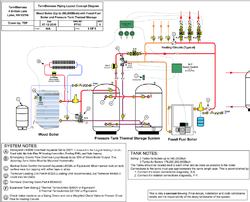M
mikefrommaine
Guest
I have a Biomass 60 in my basement in a room next to my oil boiler. Been using it for a year without storage.
I just had a couple propane tanks delivered (thanks again JP) So now I have to figure out how and where I am going to plumb them into my system.
I was thinking I might follow this diagram from Tarm. EXCEPT I dont have a termovar. It is currently plumbed with a 00r/danfoss valve
My question is how far from my boilers can I place the tanks? I dont have any room right next to the boiler and distribution system. The best place to put them in the basement is about 40' away. I would probably have about 50-60' of piping between the boiler and tanks. Is this going to cause problems? I imagine the response time when the thermostats call for heat will be delayed and I will have some heat loss from the pipes.
I just had a couple propane tanks delivered (thanks again JP) So now I have to figure out how and where I am going to plumb them into my system.
I was thinking I might follow this diagram from Tarm. EXCEPT I dont have a termovar. It is currently plumbed with a 00r/danfoss valve
My question is how far from my boilers can I place the tanks? I dont have any room right next to the boiler and distribution system. The best place to put them in the basement is about 40' away. I would probably have about 50-60' of piping between the boiler and tanks. Is this going to cause problems? I imagine the response time when the thermostats call for heat will be delayed and I will have some heat loss from the pipes.


